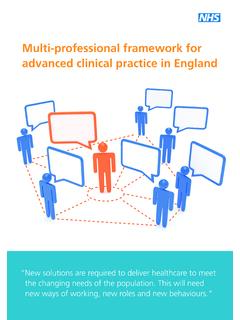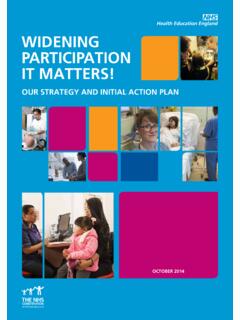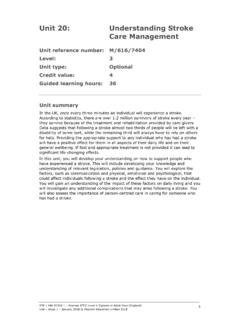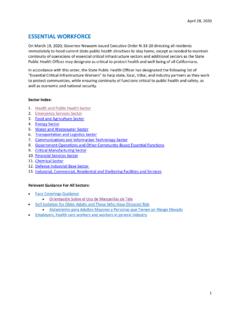Transcription of Allied Health Professions’ Support Worker Competency ...
1 Allied Health professions Support Worker Competency , Education,and Career Development Framework(draft for consultation)Realising potential to deliver confident,capable care for the work with partners to plan, recruit, educate and train the Health ..3 Part One: Background and context ..4 Background ..4 Overview of the Framework ..5 How the Framework was developed ..5 How to use this Framework ..6 Part Two: AHP Support Worker roles ..7 Examples of AHP Support Worker tasks ..8 Differences between professions ..9 Delegation and equality, diversity and inclusion ..10 Part Three: Framework Stages ..11 Entry level ( Support Worker ) ..11 Intermediate (senior Support Worker ) ..11 Assistant practitioner ..12 Summary of Framework stages ..12 Part Four: Education levels for AHP Support workers ..13 Functional skills ..13 Digital skills ..14 Skills passports ..14 Recruitment and progression pathways ..15 Part Five: The Framework: domains, competencies, and indicators ..16 Overview of the Framework domains.
2 17 Framework domains ..18 Glossary ..30 Career stages ..30 Competence ..30 End-to-end workforce strategies ..30 Functional skills ..30 Grow Your Own (GYO)..31 Knowledge and skills ..31 Scope of ..32 AHPSW Framework | Realising potential to deliver confident, capable care for the future (draft)2 ForewordSupport workers play a crucial and growing role delivering safe and effective care across the Allied Health professions (AHPs). They work across the NHS, social care , the independent sector, housing, education, and the voluntary sectors, playing an integral role supporting people s Health and wellbeing. Ensuring clear and consistent access to high-quality learning and career progression for these staff members will deliver benefits for services and their users, such as high-quality care , continuity of care , improved retention, and reduced waiting lists. Moreover, defining clear pathways into and through Support Worker roles not only increases job satisfaction and opportunities for Support workers, but also builds workforce capacity, creates a more diverse workforce, and helps secure future workforce , too often Support workers in both Health and social care face barriers to their development, deployment, and career progression.
3 These can include variation in roles, inconsistent delegation of tasks, poorly defined development routes, and lack of access to training and is a need to ensure that Support workers have the right knowledge and skills to work at the top of their scope of practice, supported by high-quality education, and can progress their careers and aspirations. This Framework seeks to Support this across Rastrick OBEC hief Allied Health professions Officer for England AHPs have been at the forefront of developing Support Worker roles, particularly in the NHS. However, from our work with Support workers and services across the country we know there is wide variation in their education and training, and how they are have developed this Framework, working closely with a wide range of partners, and would like to thank everyone who has supported us throughout this process. The Framework, alongside a suite of improvement and implementation resources from HEE, demonstrates our recognition of and commitment to this vital HardenNational Allied Health professions Lead, Health Education EnglandDeputy Chief Allied Health professions OfficerAHPSW Framework | Realising potential to deliver confident, capable care for the future (draft)3 Part One: Background and contextBackgroundHealth Education England (HEE) has published this AHP Support Worker Competency , Education and Career Development Framework to maximise the contribution of the AHP Support workforce to delivering safe and effective work will ensure that: Patients and service users have access to skilled and consistently well-trainedsupport workers who have a defined role within their team, service, andorganisation.
4 Current and prospective AHP Support workers have access to refreshed roledescriptions and standardised career/development structures that provideopportunities to follow a richer and more rewarding career pathway; Services can address current unwarranted variation in Support Worker roles,banding and progression; Support Worker roles can be at the heart of improvements in service deliveryand transformation, including new models of will Support joint approaches to the commissioning and delivery of apprenticeships, ensuring Support staff are deployed consistently across integrated care on all HEE s work to recognise and develop the AHP Support workforce can be found on the HEE Allied Health professions are art therapists, dramatherapists, music therapists, chiropodists/podiatrists, dietitians, occupational therapists, operating department practitioners, orthoptists, osteopaths, prosthetists and orthotists, paramedics, physiotherapists, diagnostic radiographers, therapeutic radiographers, and speech and language Framework | Realising potential to deliver confident, capable care for the future (draft)4 Overview of the Framework This Framework allows employers, networks, integrated care systems (ICSs)
5 And services effectively plan, develop, and deploy their AHP Support Framework provides guidance on training, education and competencies for AHP Support workers employed in NHS services and NHS funded services. It supports education providers to plan and deliver accredited education, and ICSs to take a coordinated approach. It will also be of relevance and interest to other public sector employers, including local authorities, as well as the private, independent and voluntary Framework supports three linked workforce strategies that are aimed at: local people directly into AHP entry-level roles, where vacancies exist; existing Support staff so they can perform at the top of their scope of practice; clear end-to-end progression routes linked to formal education programmes, includingaccess into AHP Framework demonstrates a clear pathway for recruitment and progression, with accompanying common and transferrable skills across eight domains:Formal knowledge and experienceSupporting patients and service usersClinical, technical and scientific roles and responsibilitiesCommunication and informationSafe and inclusive environmentsResearch and service improvementLeadershipPersonal and professional values and behavioursHow the Framework was developed The Framework was developed by King s College London, working with HEE and the AHP professional bodies.
6 Support Worker job descriptions and person specifications from across the professions were gathered via the NHS Jobs website. In total, 127 were identified and systematically reviewed to identify: detailed qualification and experience requirements across occupations and bands, general skills, behavioural requirements (such as communications , personal skills and delivering safe care ), and specific roles and responsibilities unique to individual professions . Job descriptions and personal specifications were identified as the starting point for developing the Framework because they reflect current deployment and service needs. Alongside this, existing AHP and other education, Competency and qualification Frameworks, codes and standards were also reviewed. These included: relevant apprenticeship standards, Health Technical Levels, individual professional body standards, The Core Competences of Healthcare Assistants in the European Union project outputs, the NCFE CACHE Level 3 Diploma, care Certificate, Skills for Health Career Framework, and NHS National Job Profiles and careers Framework | Realising potential to deliver confident, capable care for the future (draft)5 How to use this FrameworkSystems, employers, and staff can use the Framework in the following care systems (ICS)
7 The standardisation of job descriptionsand personal specifications across systems the relevance of current local trainingand education programmes, and work withemployers and education providers to developadditional provision across the skills passports to Support transferabletraining and with other employers in the localICS to Support consistency of roles and existing organisational job descriptionsand personal specifications to ensure theyare up to date and consistent, includingqualification requirements, and that they enablethe full utilisation of Support Worker skills existing grade, skill mix, and deploymentto determine the need for new, extended, orenhanced Support Worker professional and clinical all team members are clear about roleboundaries and scope of practice, and supportthe safe and appropriate delegation of tasksand better team working throughcompetency-based approaches to skill personal development plans andappraisals for AHP Support Support the learning and development ofsupport Worker providers the design and delivery ofoccupationally specific education programmes,including common learning across AHP supportroles to be Support progression through Support workercareers, including into partnership working at system andindividual employer Support workers your current and future continuing professional developmentand career Framework should also be used alongside and supplemented by specific professional body standards, codes and frameworks where they Framework | Realising potential to deliver confident, capable care for the future (draft)6 Part Two.
8 AHP Support Worker rolesThe country s 170,000 staff employed in the 14 AHPs, across Health and social care improve people s Health and wellbeing, deliver public Health interventions, and reduce the demand for primary, emergency, and urgent care . AHPs work across agencies and boundaries, often in multidisciplinary teams and in new service AHP Support workforce works with registered staff to deliver patient and client care and Support , working under a range of supervisory arrangements within agreed guidelines and protocols. They often work as part of multidisciplinary teams developing treatment plans under supervision but can also work with individual practitioners or autonomously within the scope of their role and under guidance and following Support Worker responsibilities can range from performing routine tasks, such as welcoming and preparing service users for treatment, to direct clinical and Support tasks such as applying dressings and treatments or helping service users meet their care workers are employed in the majority of AHP services, working with registered professionals and providing care and treatment, for example by.
9 Helping dietitians assess, diagnose, and treat service users dietary and nutritional problemsAssisting occupational therapists in supporting people to carry out everyday tasksHelping people who need orthotics to Support their limbsAssisting physiotherapists in improving people s mobilityWorking with podiatrists to help care for patients with foot or ankle conditionsUsing prosthetists' designs to make artificial limbsRadiography Support workers assist diagnostic and therapeutic radiographers Support people through diagnose and treatmentHelping speech and language therapists monitor swallowing difficulties and carry out therapy interventions to Support communicationsAHPSW Framework | Realising potential to deliver confident, capable care for the future (draft)7 Examples of AHP Support Worker tasksPodiatry assistant Applying dressings andtreatments, Booking appointments, Taking insole templates, Advising patients andtheir carers on foothealth and assistant Assisting service users withtherapeutic dietary choices, Recording and analysing serviceusers food and fluid intake, Support with enteral tube feeding, Taking and recordinganthropometric measurements, supporting service users inachieving their personal dietarygoals, Delivering individual and groupeducation in acute and therapy assistant Helping patients adapt to life after majorsurgeries such as hip replacement, supporting children with disabilities takingpart in school and play activities, Helping people living with dementia todevelop strategies, Helping people living with mental illness getback into everyday activities such as work orvolunteering, supporting older people to stay in theirhomes by assessing and providing minoradaptions and clinic technician Visual field testing.
10 OCT scans of the retina andoptic nerve, Vision testing on adults, Focimetry (measuring glasses), Photography, Dilation, Intraocular pressures, Biometry (pre-op cataractmeasurements), Colour vision testing andhistory and language therapy assistant Booking appointments and managingcaseloads, Preparing communication therapyservices, Providing therapy for patients afterassessment by a registered SLT, Providing swallowing care plans, Providing dysphagia training torelatives, carers and ward staff, supporting patients to talk after a heador neck injury, Modelling play and language between professionsThe distinct nature of each AHP and the populations they Support , along with the historic evolution of roles, means that the deployment, grading, and skill mix of AHP Support workers vary. Support workers in different AHP occupations are therefore likely to start at different points of the Framework, some at entry level, some at intermediate, and some at assistant practitioner. In physiotherapy, for example, Support Worker roles often commence at NHS pay band 2 equivalent to the entry-level stage of theFramework.









![Midlands [1 of 2] - hee.nhs.uk](/cache/preview/6/c/1/4/2/e/2/7/thumb-6c142e2790d053a442bd8a3e81c79697.jpg)



